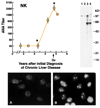Autoantibodies to tumor-associated antigens: reporters from the immune system
- PMID: 18364012
- PMCID: PMC2719766
- DOI: 10.1111/j.1600-065X.2008.00611.x
Autoantibodies to tumor-associated antigens: reporters from the immune system
Abstract
Although autoantibodies have been recognized as participants in pathogenesis of tissue injury, the collateral role of autoantibodies as reporters from the immune system identifying cellular participants in tumorigenesis has not been fully appreciated. The immune system appears to be capable of sensing aberrant structure, distribution, and function of certain cellular components involved in tumorigenesis and making autoantibody responses to the tumor-associated antigens (TAAs). Autoantibodies to TAAs can report malignant transformation before standard clinical studies and may be useful as early detection biomarkers. The autoantibody response also provides insights into factors related to how cellular components may be rendered immunogenic. As diagnostic biomarkers, specific TAA miniarrays for identifying autoantibody profiles could have sufficient sensitivity in differentiating between types of tumors. Such anti-TAA profiles could also be used to monitor response to therapy. The immune system of cancer patients reveals the immune interactive sites or the autoepitopes of participants in tumorigenesis, and this information should be used in the design of immunotherapy.
Figures






References
-
- Tan EM. Antinuclear antibodies: diagnostic markers for autoimmune diseases and probes for cell biology. Adv Immunol. 1989;44:93–151. - PubMed
-
- Rose NR, Mackay IR. The Autoimmune Diseases. New York: Academic Press; 1998.
Publication types
MeSH terms
Substances
Grants and funding
LinkOut - more resources
Full Text Sources
Other Literature Sources
Research Materials

